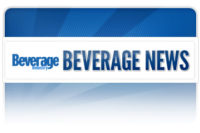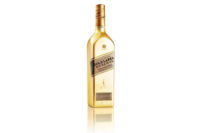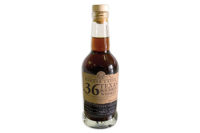New flavors, packages boost spirits category
Vodka and whiskey dominate category growth

Diageo launched a new line of reduced-calorie vodkas infused with natural flavors. Smirnoff Sorbet Light vodkas represent the trend toward natural, healthier spirits. (Image courtesy of Diageo North America)


Big Easy Blends expanded its portfolio of premixed cocktails with Cordina Light 100-calorie pouches. (Image courtesy of Big Easy Blends)

Beam Inc. released Canadian Club Dock No. 57, a blackberry-flavored whiskey that was designed to help bring new consumers of legal drinking age into the whiskey category. (Image courtesy of Beam Inc.)




Although the vodka sub-category remains the No. 1 segment in terms of volume sales, whiskey has become so popular that it is beginning to take over as the No. 1 spirit on a dollar sales basis, according to Bump Williams Consulting’s monthly wine and spirits report, which cites Chicago-based SymphonyIRI data.
“Vodkas used to be the single biggest piece of the pie, and vodka still is in terms of the volume basis … but on a dollar basis, whiskey is the single biggest segment of the spirits category,” says Bump Williams, chief executive officer and president of the Stratford, Conn.-based company. “That is a massive shift.”
According to SymphonyIRI InfoScan data for the 13 weeks ending Feb. 24, 2013, whiskey surpassed vodka dollar sales by approximately $1.5 million, increasing 23.1 percent compared with the same time frame of the previous year to reach $234.9 million. Dollar sales for the vodka sub-category increased 13.7 percent compared with the prior-year time period, reaching $233.3 million, according to Bump Williams Consulting’s report.
The Innova Database also tracked a 61 percent increase in new vodka product launches in 2012, demonstrating the most growth in the spirits category, followed by whiskey with a growth rate of 58 percent for new product launches, says Natalie Tremellen, market analyst for Innova Market Insights, Duiven, the Netherlands.
IBISWorld’s November 2012 report, “Distilleries in the US,” notes that whiskey is the most popular spirit in the United States and accounts for 29.8 percent of revenue for the category, while vodka makes up 25.6 percent. Within the whiskey sub-category, sales of high-end and super-premium products account for 57.4 per-cent of all whiskey sales, suggesting that consumers are willing to pay for branding and quality, the Santa Monica, Calif.-based market research firm reports. Media such as AMC’s TV show “Mad Men” also continue to popularize the sub-category, the report adds.
The emergence and growth of craft spirits also is a major reason that whiskey overtook vodka in dollar sales, because most craft spirit launches are within the whiskey sub-category, Bump Williams Consulting’s Williams says.
In terms of volume, bourbon and Tennessee whiskey made up the largest segment within the sub-category, increasing 5.2 percent, reports the Distilled Spirits Council of the United States (DISCUS), Washington, D.C. Irish whiskey volume grew 22.5 percent in volume, and single-malt Scotch whisky also grew double digits with an increase of 13 percent in volume, it adds.
A palette full of flavors
Despite the growing popularity of whiskeys, flavored vodkas are up 25 percent, according to Bump Williams Consulting’s Williams. Berry flavors are the most popular within the segment; however, other flavored vodkas such as sweet, indulgent and unusual flavors are up nearly 70 percent, he says. Compare this to the spirits category as a whole, which increased 12 percent in volume and nearly
14 percent in dollar sales during the 52 weeks ending Feb. 24 compared with the same time frame from the previous year, the firm reports.
Currently, the market offers nearly 175 different flavors for the vodka sub-category, including cookie dough, root beer and artichoke, Williams says.
“It’s all about a world of flavors,” he says. “That’s where this industry’s obviously going to and that’s what’s driving a lot of the growth to it.”
Innova’s Tremellen also notes the expansion of berry flavors within the vodka segment; however, she says the most popular are citrus flavors.
“Flavor innovation has been vast for vodka with a wide variety of savory and sweet flavor inclusions available, such as green tea and chocolate,” she says. “However, citrus flavors remain the most prevalent, with lemon and grapefruit being the most popular. Berry flavor choices have also expanded, with elderberry and blueberry, for example, being alternative choices to more traditional raspberry and strawberry flavors.”
Chicago-based market research firm Mintel also notes in its November 2012 report, “White Spirits and RTDs,” that volume sales in the vodka segment grew
34 percent between 2007 and 2012, driven largely by the expansion of flavored vodkas. DISCUS adds that 46 percent of all spirits in the United States have a flavor component, whereas in 2011 flavored spirits accounted for 27 percent of spirits volume in the United States. Today, approximately 220 different flavors are available across all spirits sub-categories, it adds.
For instance, whiskeys such as Red Stag by Jim Beam from Deerfield, Ill.-based Beam Inc., Jack Daniel’s Tennessee Honey whiskey from Louisville, Ky.-based Brown-Forman Corp., and Crown Royal Maple from Norwalk, Conn.-based Diageo North America feature an added flavor, says Frank Coleman, senior vice president for public affairs with DISCUS. White whiskeys also have increased in popularity as of late, he adds. Last month, Beam Inc. launched Jacob’s Ghost white whiskey, which is aged slightly to impart flavor but not enough to darken the color of the liquid.
Outside of vodka and whiskey, all other segments of the spirits category increased in the 52 weeks ending Feb. 24 compared with the same time frame from the previous year, Bump Williams Consulting reports. On a volume basis, rum was up 4.7 percent, tequila was up 5.4 percent, gin was up 7 percent, cognac was up 11.3 percent, brandy was up 0.2 percent, cordials were up 7.8 percent, and prepared cocktails were up 33.3 percent during the measured time period, according to the report.
Packing a pouch
Dollar sales for Beam Inc.’s Skinnygirl brand were up 44.5 percent in the 52 weeks ending Jan. 27 compared with the prior year in SymphonyIRI-measured channels, making it the
No. 4 best-selling brand in the premixed cocktails segment and inspiring a wave of low-calorie mixed drinks.
“That whole persona of the Skinnygirl brand or brand equity has really permeated into that female shopping demographic,” Bump Williams Consulting’s Williams says.
According to IBISWorld’s September 2012 report, “RTD Mixed Spirit Production,” approximately 55 percent of ready-to-drink (RTD) cocktail consumers are women, and the majority of consumers in the category also are younger than 30 years of age. As consumer spending continues to recover, RTD cocktails are expected to target young, health-conscious consumers, the report states.
Within the premixed cocktails segment, pouch packaging also has become popular among consumers.
Verona, Pa.-based American Beverage Corp.’s Daily’s brand, for instance, topped the premixed cocktails segment despite its 8.1 percent loss in dollar sales during the time frame, SymphonyIRI data shows. Diageo’s Jose Cuervo brand came in at the No. 2 spot with a 5.5 percent increase, while the company’s Captain Morgan brand landed the No. 3 spot, increasing 213.6 percent during the time frame in measured channels. Similarly, Rochester, N.Y.-based North American Breweries’ Seagram’s brand topped the coolers category with a 56.1 percent increase, according to SymphonyIRI data. Daily’s and Seagram’s Escapes are both available in pouches.
Pouches are convenient, price effective and portable; however, they can be difficult for retailers to merchandise, Bump Williams Consulting’s Williams points out. The pouches can’t simply stand on a shelf; they must hang from a special rack, he says. Plus, they can be difficult to pull off the rack, and the edges can be sharp, he adds. Nevertheless, along with flavor innovation, pouches are a large part of the innovation in the spirits category, he says.
Innova’s Tremellen also has noticed the popularity of premixed cocktail pouches, saying: “[Premixed cocktails in pouches] emulate the in-bar experience without the price tag. Demand should, therefore, increase.”
Driving trends
Although premixed cocktails are popular partially because of their low price point, more costly spirits continue to hold their own in the industry, according to experts. Despite the downturn of the economy in 2008, consumers continued to purchase premium spirits and instead shifted their consumption from on-premise to off-premise, IBISWorld’s “Distilleries in the US” report states. Additionally, revenue for super-premium spirits was up 10.8 percent in 2012 compared with 2011, and from 2003 to 2012, the price segment increased $2.4 billion, according to DISCUS data.
Premiumization has been the main driver of revenue growth for the spirits category in the last five years, according to IBISWorld. However, the emergence of a cocktail culture in the mid-2000s also has pushed industry performance further, it adds. This also can be attributed to craft spirits, which focus on product quality and the story behind the spirit.
“Craft spirits are just a natural progression from the success associated with craft beer,” Innova’s Tremellen says. “Consumers are also looking for original flavors and a story behind their drink and are prepared to pay a premium for the experience.”
Although the craft distillery segment of the market remains small, it is growing rapidly, according to experts. Larger distilleries are even acquiring some of the craft distilleries, which is a trend to be watched, DISCUS’s Coleman says.
Other trends in the overall spirits category include the move toward more natural ingredients; the use of herbs, spices, botanicals and flowers for flavor; triple distillation; and fusion products, Innova’s Tremellen says.
Earlier this year, Purchase, N.Y.-based Pernod Ricard USA launched Absolut Hibiskus, which blends hibiscus and pomegranate flavors.
"In recent years, a sophisticated trend has emerged as more and more bartenders are adding floral ingredients to the mix,” said Eric Horowitz, senior brand manager for Absolut with Pernod Ricard USA, in a statement. "We are thrilled to bring a distinct, floral-flavored vodka to bartenders and consumers alike with Absolut Hibiskus, a fiercely original combination of floral and fruit flavors poised to create a new trend in vodka cocktails.”
The company also launched Malibu Red last year in collaboration with R&B singer, songwriter and actor Ne-Yo. Malibu Red is a 70-proof blend of Caribbean coconut rum and silver tequila.
Millennials might be driving these trends, as they are the largest group of consumers next to baby boomers. By the end of 2015, the entire generation will reach legal drinking age, representing a major population increase and an opportunity for alcohol beverages, Mintel’s November 2012 “White Spirits and RTDs” report states.
Building on its past successes, the spirits category is expected to increase between 5 and 7 percent in the next five to 10 years, Bump Williams Consulting’s Williams says.
“Spirits have done everything right,” he says. “They’ve captured and maintained their share of on-premise; they’ve expanded their presence in the off-premise; they’ve tapped into the new legal drinking age consumer with all of these sweet drinks; [and] they’ve really capitalized on moving the 29- to 40-year-old consumer up along that purchase pyramid of spirits.” Plus, the craft distilling segment has added a new dimension to continued spirits growth, he adds.
In 2012, distilled spirits grew their market share of sales for the third consecutive year to 34.3 percent, taking some share from both beer and wine, DISCUS reports. Furthermore, the repeal of Prohibition-era Blue Laws has supported revenue with 16 states adopting Sunday sales of distilled spirits and 17 states passing legislation to allow spirits tastings at liquor stores since 2002, it adds.
Looking for a reprint of this article?
From high-res PDFs to custom plaques, order your copy today!










